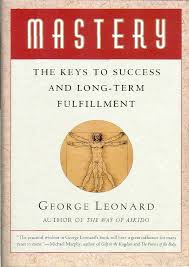 Mastery: The Keys to Success and Long-Term Fulfillment does not quite fit in with the foresight classics I’ve been focusing on recently, but it’s one of those books that’s been on my “to read” list far too long. It was published in 1991, and drawn largely from Leonard’s experience in teaching Aikido, which he’s been doing since the 1970s. The premise is that you want to learn to master something, whether it’s aikido, surgery….or perhaps foresight. He introduces the concept of the mastery curve: “Learning any new skill involves relatively brief spurts of progress, each of which is followed by a slight decline to a plateau somewhat higher than that which preceded it.” So, it’s not a consistent steady of curves, but ups, downs, and plateaus. It takes time for muscle memory to click in, but when it does, you have it. It’s easier to visualize with something physical like sports. When I was doing yoga consistently, I remember the long process of learning to do a headstand, but when I finally got it, I got it. It became part of muscle memory, but then came another long plateau.
Mastery: The Keys to Success and Long-Term Fulfillment does not quite fit in with the foresight classics I’ve been focusing on recently, but it’s one of those books that’s been on my “to read” list far too long. It was published in 1991, and drawn largely from Leonard’s experience in teaching Aikido, which he’s been doing since the 1970s. The premise is that you want to learn to master something, whether it’s aikido, surgery….or perhaps foresight. He introduces the concept of the mastery curve: “Learning any new skill involves relatively brief spurts of progress, each of which is followed by a slight decline to a plateau somewhat higher than that which preceded it.” So, it’s not a consistent steady of curves, but ups, downs, and plateaus. It takes time for muscle memory to click in, but when it does, you have it. It’s easier to visualize with something physical like sports. When I was doing yoga consistently, I remember the long process of learning to do a headstand, but when I finally got it, I got it. It became part of muscle memory, but then came another long plateau.
He has observed that most people don’t persevere to mastery, because it’s a long slow journey and we prefer instant gratification. He suggests a few common responses:
- The dabbler approach each new sport, career opportunity or relationship with enormous enthusiasm. They are overjoyed with the first spurt of progress, but lose heart with the plateau, and move on to the next new thing, and repeat the cycle.
- The obsessive won’t settle for second best, and wants to master a new skill right away and dives in deep. The first spurt of progress is expected, but the plateau is not. And they keep digging deeper, trying harder, not accepting that it takes time.
- The hacker is happy to sorta get the hang of something new and is happy to stay there indefinitely.
Recognize someone? Of course, the point is that mastery takes time, patience, and perseverance. Chapter 4 is aptly titled “love the plateau.” He relates how aikido provides a great lesson in that it is characterized by long plateaus, and rather than seeing them as annoying in-between periods, to learn to appreciate them. Learn to love the process as well as the product. Appreciate the journey. Put one more way, we tend to treat “in-between” times as necessary evils, but most of our lives are really in-between. It suggests a re-orientation in which goals are useful in setting a direction, but they are not the end-all, be-all.
Here are five practical tips for achieving mastery:
- Instruction. Arrange for first-rate instruction (you can learn a lot on your own, but if the goal is mastery….).
- Practice. A practice is anything you practice on a regular basis, not just to gain something else, but for its own sake (you can think of yourself as having a foresight practice)
- Surrender. Surrendering to your teacher and the demands of the discipline (cultivate the mind and hear of the beginner at every stage along way)
- Intentionality. Visualizing what you want (every master is a master of vision – what’s your vision of your future?)
- The edge. While zealots of practice, masters take risks for the sake of higher performance
While the lessons here are life lessons, it was useful for me to think of master in terms of my foresight practice. [And reminding myself it is a practice and I am working toward mastery, and love the journey]. And for students it’s a solid advice on how to conceptualize a career/practice as a futurist.
For those with an inclination to things Integral, Leonard also wrote a wonderful book The Life We are Given about Integral Transformative Practice with Michael Murphy (who also wrote another favorite of mine “The Future of the Body: Explorations into the Further Evolution of Human Nature” about pushing the frontiers of our human performance). Andy Hines
[…] in mind as foresight practitioners. We need to put in the hours to master our craft [see post on Mastery and Foresight practice]. The Houston Foresight Master’s program consists of 12 courses. We estimate each course takes […]